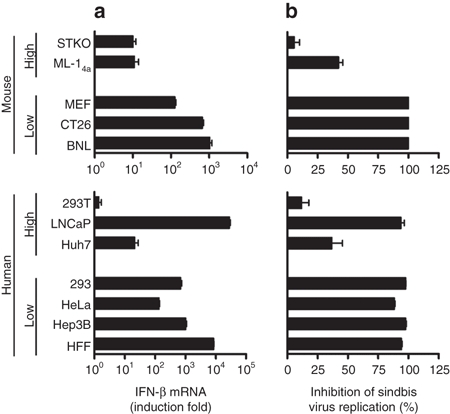Figure 2.

Correlation of low IFN-β production with high susceptibility to SBV infection. Representative mouse and human cell lines with extremely low or high susceptibility to SBV infection were examined with respect to their abilities to synthesize IFN-β in response to poly(I:C) stimulation. (a) IFN-β production. Cells were left untreated or transfected with poly(I:C) (1 µg/ml) for 6 hours. Total RNA was isolated from the control or poly(I:C)-transfected cells, and the levels of IFN-β mRNA were determined by qRT-PCR. The results are expressed as fold induction, with the IFN-β mRNA levels of poly(I:C)-treated cells divided by those of the control cells. (b) Inhibition of SBV replication by conditioned medium. Representative cell lines were transfected with poly(I:C) for 6 hours. Fresh medium was then placed on the cells, and they were incubated for another 18 hours. The conditioned medium from the poly(I:C)-treated mouse or human cells was collected, diluted with fresh medium at a 1:1 ratio, and then applied to ML-14a or 293T cells, respectively. After an overnight incubation, the cells were challenged with EGFP-expressing SBV for 24 hours. EGFP(+) cells were analyzed by flow cytometry. Data were presented as percentage of inhibition of SBV infection, calculated using the formula: [(A − B)/A] × 100%, where A is the percentage of EGFP(+) cells from cells treated with the control medium, and B is the percentage of EGFP(+) cells from cells treated with the conditioned medium. EGFP, enhanced green fluorescence protein; IFN, interferon; SBV, Sindbis virus.
